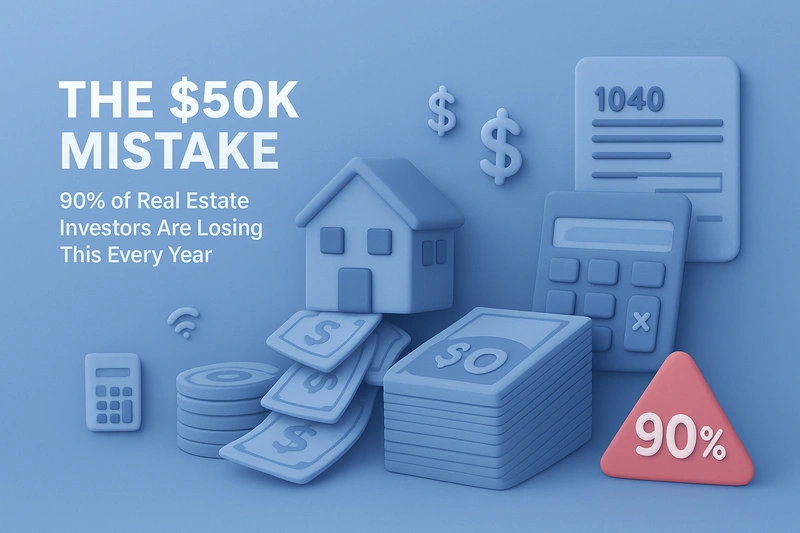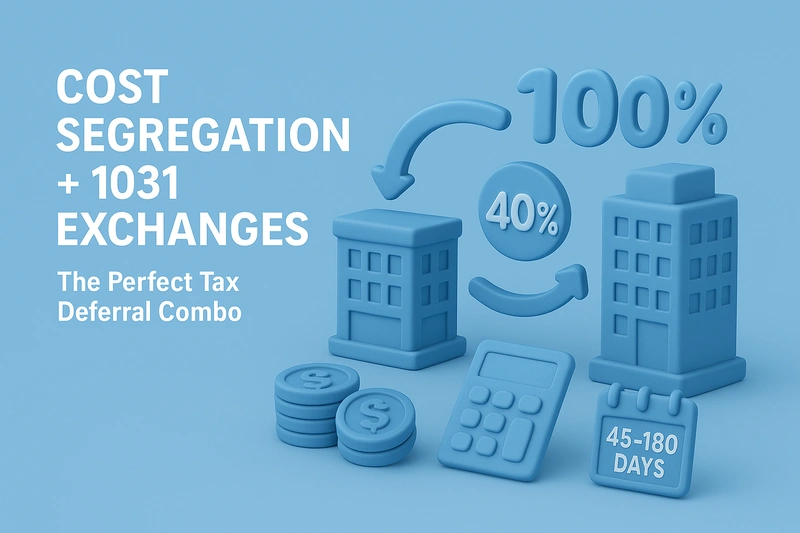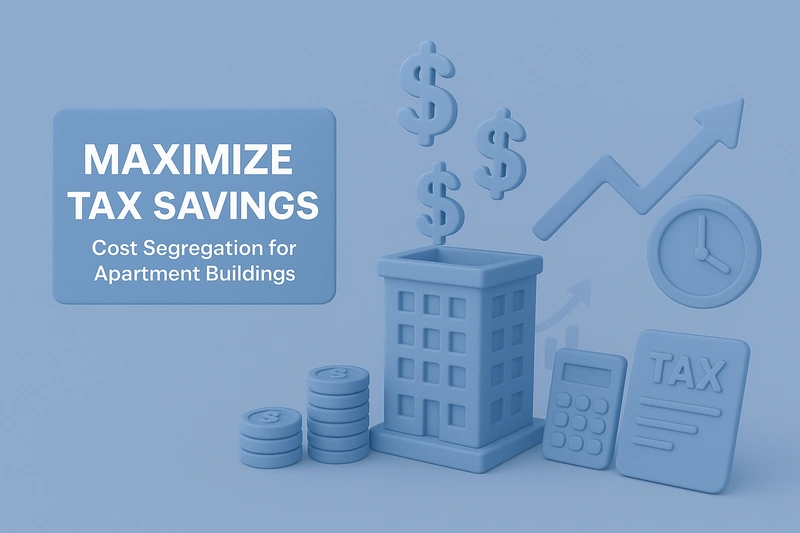Every year, thousands of real estate investors unknowingly write checks to the IRS for tens of thousands of dollars more than they legally owe because they're missing tax intelligence. And the most painful part? This money, once gone, can never be recovered.
Picture this: You purchase a $1 million rental property. Like most investors, you dutifully depreciate it over 27.5 years, claiming about $36,000 in annual depreciation. You feel smart, reducing your taxable income.
But here's what you don't know. You're actively losing $50,000 or more in tax savings over the next five years. That's real money hemorrhaging from your investment returns, straight into the government's coffers.
The culprit? Ignoring cost segregation, an IRS-approved strategy that accelerates depreciation on significant portions of your property. While sophisticated institutional investors never miss this opportunity, individual real estate investors remain largely in the dark.
Studies suggest that 90% of qualifying properties never undergo cost segregation, representing billions in unnecessary tax payments annually.
Rather than learning a new tax trick, this is about stopping a massive financial leak that's silently draining your real estate profits.
In this article, we'll expose exactly how much money you're losing, why it's happening, and most importantly, how to immediately plug this costly gap in your investment strategy.
The Hidden Tax Loss Most Investors Don't See
Here's the default mistake that's costing real estate investors thousands: When you buy an investment property, your accountant likely sets up depreciation the "standard" way: spreading the entire building cost evenly over 27.5 years for residential property or 39 years for commercial. Simple, clean, and catastrophically expensive.
What your accountant probably isn't telling you is that you're miscategorizing a fortune in assets.
The IRS recognizes that 20-35% of your building isn't actually "building" at all. It's personal property and land improvements that qualify for 5, 7, or 15-year depreciation.
We're talking about flooring, fixtures, parking lots, landscaping, certain electrical and plumbing systems, and dozens of other components. By lumping everything together, you're voluntarily extending your tax deductions by decades.
Let's put real numbers to this loss. Take that $1 million property (assuming $200,000 for land). Without cost segregation, you're depreciating $800,000 over 27.5 years. About $29,000 annually.
But with proper cost segregation, approximately $240,000 (30%) gets reclassified to shorter depreciation periods. In Year One, this acceleration could generate $80,000 or more in depreciation instead of $29,000. At a 37% tax rate, that's $18,870 in additional tax savings. Money you're currently handing to the IRS instead of keeping in your pocket.
The psychology here is critical.
This isn't about "tax optimization" or "maximizing deductions." You're literally paying taxes on phantom income. Every year you delay is money permanently lost. You can never reclaim those missed deductions from prior years without a cost segregation study.
The most stunning statistic? Industry estimates suggest only 10% of qualifying properties utilize cost segregation. That means 90% of real estate investors are actively bleeding money through unnecessary tax payments.
It's the equivalent of paying retail price when a 30% discount is automatically available, except worse, because this discount compounds annually.
The True Cost of Ignorance: Breaking Down the $50K Loss
Let's dissect a real-world example that mirrors thousands of investment properties across America.
Sarah purchases a 20-unit apartment complex for $2 million in January 2024. Like most investors, she relies on her CPA's standard approach: $400,000 allocated to land (non-depreciable), and $1.6 million to the building, depreciated straight-line over 27.5 years. Annual depreciation: $58,182.
Here's where Sarah starts hemorrhaging money. A proper cost segregation study would reveal:
- Appliances and carpeting (5-year property): $120,000
- Parking lot, fencing, landscaping (15-year property): $200,000
- Specialized plumbing and electrical for appliances (5-year property): $80,000
- Security systems and fixtures (7-year property): $60,000
- Site improvements and sidewalks (15-year property): $140,000
That's $600,000, 37.5% of her building cost, being incorrectly depreciated over 27.5 years instead of 5-15 years.
The First-Year Bloodbath:
- Standard depreciation: $58,182
- Cost segregation depreciation: $198,000+ (with bonus depreciation consideration)
- Additional deduction: $139,818
- Tax savings at 37% rate: $51,732
Sarah just lost $51,732 in Year One alone. But it gets worse.
The Compound Catastrophe: That $51,732 is gone and working against her. If Sarah had reinvested those tax savings at a modest 8% return, it would have grown to $75,000 over five years.
Meanwhile, she's paying interest on loans that could have been partially paid down, missing out on additional property acquisitions, and watching her competitors leverage these savings to outbid her on deals.
Monthly Cash Flow Massacre: The immediate impact: Sarah loses $4,311 in monthly cash flow. For an investor managing tight debt service coverage ratios, this could mean:
- Inability to qualify for additional loans
- Reduced emergency reserves
- Delayed property improvements
- Lost negotiating power with lenders
The 5-Year Funeral: By Year 5, Sarah's cumulative loss exceeds $165,000 in tax savings alone. Factor in opportunity costs, and the real damage approaches $250,000. That's enough for a down payment on another property, gone forever.
The 10-Year Tragedy: Continue this pattern for a decade, and Sarah has forfeited over $300,000 in direct tax benefits, plus another $200,000 in compound growth opportunities. Half a million dollars evaporated through simple ignorance.
The most infuriating part? This loss was entirely preventable. The IRS explicitly blessed cost segregation. The tax code allows it.
Sarah simply didn't know to ask, and her advisors didn't tell her. Every year, thousands of investors repeat Sarah's mistake, collectively losing billions to the Treasury that could be building wealth in their portfolios.
Why Smart Money Always Uses Cost Segregation
Walk into any institutional real estate firm — Blackstone, Starwood, Brookfield — and ask about their depreciation strategy. Every single property undergoes cost segregation. No exceptions.
These firms don't leave money on the table, and their investors would revolt if they did. Yet individual investors, owning the exact same types of properties, routinely skip this critical step.
The knowledge gap is staggering and expensive. While institutional investors have teams of tax strategists, most individual real estate investors rely on generalist CPAs who handle everything from personal returns to small business bookkeeping.
These CPAs, though competent, often lack specialized knowledge in real estate taxation. They default to "safe" straight-line depreciation, unknowingly costing their clients fortunes.
The Deadly Misconceptions:
"It's too expensive." A fully engineered cost segregation study typically ranges from $2,500-$5,000, depending on your property type, with rapid reports available for just $950. Against $50,000+ in first-year tax savings, that's a 1,000-2,000% immediate ROI. You're not "spending" on the study, you're losing money by not doing it.
"It triggers audits." False. The IRS published detailed guidelines supporting cost segregation. They expect sophisticated investors to use it. You're more likely to face questions for leaving money on the table than for claiming legitimate deductions.
"Only for huge properties." Another wealth-destroying myth. While $300,000 is often cited as a starting point where cost segregation makes sense, there's no hard cutoff. We've successfully performed studies on lower-priced properties when the tax strategy warranted it. The real question isn't your property's value; it's whether the tax savings justify the study cost based on your specific situation. Your CPA can help determine if the numbers work for you.
The Professional Blind Spot:
Here's the uncomfortable truth: Many CPAs don't mention cost segregation because they don't fully understand it themselves. They fear complexity, lack engineering knowledge to identify components, or simply haven't updated their practices since the 1990s. Their ignorance becomes your loss. Smart money doesn't tolerate such expensive oversights.
The Three Biggest Losses from Skipping Cost Segregation
1. Immediate Cash Flow Loss
Every month, without cost segregation, is money drained from your operating account. On a $2 million property, you're losing $4,000-$8,000 in monthly cash flow through excess tax payments. That’s cash you can't use for mortgage payments, property improvements, or reserves.
Consider the domino effect: That missing $6,000 monthly could cover hiring a full-time property manager, upgrading units to command higher rents, or building reserves to weather vacancies.
Instead, you're grinding through thin margins while the IRS cashes checks it shouldn't receive. For investors managing multiple properties, this monthly shortfall compounds into a six-figure annual catastrophe. Your debt service coverage ratios suffer, banks question your next loan application, and you're stuck explaining why your cash flow appears anemic despite owning valuable real estate.
2. Compound Growth Loss
Here's where the real wealth destruction occurs. Those $50,000 first-year tax savings don't just sit idle. In competent hands, they multiply. Reinvested at 10% annually (below average real estate returns), it becomes $80,525 in five years. Use it as a down payment on another property appreciating at 5% annually with 4:1 leverage, and you're looking at $100,000+ in additional equity.
But you don't have that money. It went to the IRS instead of working for you. While savvy investors use cost segregation savings to rapidly expand portfolios, you're stuck in slow-motion growth. They buy three properties while you struggle to finance your second.
They compound wealth exponentially; you progress arithmetically. Over a 20-year investing career, this compound effect transforms into millions in lost net worth. The tragedy? Every year you delay starts a new compound loss cycle that you can never recover.
3. Strategic Flexibility Loss
Cash is oxygen for real estate investors, and cost segregation provides breathing room that most investors desperately need. Without those tax savings, you lose critical strategic options.
Market downturn? You lack reserves to weather reduced rents. Amazing deal appears? No cash for the down payment. Property needs urgent repairs? You're scrambling for expensive hard money loans.
This inflexibility extends to financing. Lenders love strong cash flow, and cost segregation dramatically improves your debt service coverage ratios. Without it, you're getting rejected for loans or accepting worse terms: higher rates, lower LTVs, and personal guarantees.
You're negotiating from weakness because your financial statements show artificially depressed cash flow. Strategic investors use cost segregation to demonstrate financial strength; you're showing unnecessary weakness.
Red Flags You're Losing Money Right Now
The warning signs are glaring once you know what to look for. If any of these apply to you, you're actively hemorrhaging money:
You've never heard of cost segregation. Ignorance isn't bliss; it's expensive. While you were unaware, you've been overpaying taxes for years. Every property, every year, compounding losses.
Your CPA hasn't mentioned it. A damning indictment. Either they don't know (incompetence) or didn't bother telling you (negligence). Either way, their silence costs you thousands annually.
You're depreciating everything over 27.5/39 years. The classic mistake. You're treating carpeting, appliances, and parking lots like they're part of your building's foundation. The IRS thinks you're crazy for volunteering to delay your deductions by decades.
You own commercial property, apartments, or rentals over $300K. You're likely leaving significant tax savings on the table. Even if your property is valued below this threshold, don't automatically rule it out. We've helped investors with lower-valued properties achieve meaningful savings when their tax situation made it strategic.
Quick Loss Calculator: Take your property's depreciable basis, multiply by 0.30 (typical reclassification percentage), then multiply by 0.37 (assumed tax rate). That's roughly your first-year loss. Own a $1 million property? You're losing about $30,000 this year alone.
The Urgency Factor: Unlike many tax strategies, you can't retroactively claim cost segregation benefits without a formal study. Every tax year that closes is money permanently forfeited. More than a deadline, April 15th is a funeral for thousands of dollars you'll never see again.
Taking Action: Stopping the Bleeding
The financial hemorrhaging stops now. Here's your immediate action plan:
Step 1: Audit Your Current Depreciation. Pull your last three tax returns. Look at Form 4562. If you see all your property depreciated over 27.5 or 39 years, you're bleeding money. Calculate your cumulative loss, it'll motivate immediate action.
Step 2: Calculate Potential Recovery. Good news: The IRS allows retroactive cost segregation through a "change in accounting method" (Form 3115). You can capture all missed depreciation in the current year, a massive catch-up deduction. Own properties for five years? You might be sitting on $100,000+ in immediate deductions.
Step 3: Cost-Benefit Analysis. Simple math: Properties around $300,000 and above often see 10-20x ROI from cost segregation. Full studies typically cost $2,500-$5,000, depending on your property type, with rapid assessments available for just $950 to help you evaluate potential savings.
Finding Qualified Professionals: Skip generalists. You need:
- Engineering-based firms (not "rule of thumb" estimates)
- Proven track record with similar properties
- Detailed, audit-ready documentation
- References from other investors
Timeline to Cash:
- Initial consultation: 1 week
- Study completion: 2-4 weeks
- Tax filing/amended returns: 2-4 weeks
- Total: 45-60 days to stop the bleeding
Every day you delay costs real money. While you're "thinking about it," another $100+ flows from your account to the IRS. The meter's running. Make the call today.
From Loss to Gain
Let's face the brutal truth: You've likely lost $50,000 or more. Not in some market crash or bad investment, but through simple ignorance of cost segregation. That money didn't vanish in a dramatic failure; it bled out slowly, tax return by tax return, while you focused on finding deals and managing properties.
This isn't about adding a "smart tax strategy" to your toolkit. It's about stopping a massive financial wound that's been draining your wealth for years. Every property you've owned, every year you've filed taxes without cost segregation, represents thousands in unnecessary payments to the IRS.
Money that should be building your empire instead funded government spending.
Your Immediate Action Items:
- Calculate your losses today. Take your total property values, estimate 30% in accelerated depreciation, multiply by your tax rate. That number will nauseate you. Good. Use that feeling.
- Call a cost segregation specialist this week. Not next month. Not "when things slow down." This week. Every day costs money.
- Review all your properties immediately. Current properties, past properties still owned, and recent acquisitions. All are candidates for immediate savings.
Here's the paradigm shift: Stop thinking "tax planning" and start thinking "loss recovery." You're not optimizing, you're stopping hemorrhaging. This is about not being foolish with your money.
Contact R.E. Cost Seg now for a free preliminary analysis of your property portfolio. In just 15 minutes, we'll show you exactly how much you're losing and how quickly we can stop the bleeding.
The choice is simple: Continue overpaying taxes by tens of thousands annually, or take action today with RE Cost Seg. Your future self will thank you for every dollar you stop sending unnecessarily to the IRS.






